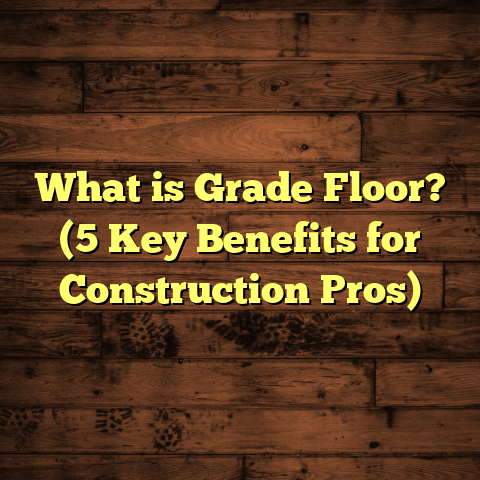What is Finger Jointed Flooring? (5 Benefits for Durability)
I remember standing in a client’s living room once, staring at their old hardwood floor that was cracked, warped, and showing its age. They were torn between replacing it with expensive solid hardwood or going with cheaper laminate options that didn’t quite have the look or feel they wanted. The question was: how could they get a durable, beautiful wood floor without paying a fortune? That’s when I brought up finger jointed flooring.
It might sound like a technical term best left to lumber experts, but actually it’s a clever way to create strong, stable, and affordable wood flooring from smaller pieces of timber. Over the years, I’ve installed finger jointed floors in everything from cozy historic homes to busy commercial offices. Let me take you through what finger jointed flooring is, why it’s so durable, and why it might be just the right choice for your next project.
What is Finger Jointed Flooring?
At its core, finger jointed flooring is made by joining shorter pieces of wood end-to-end using a special interlocking pattern that looks like the fingers of two hands fitting together — hence the name. These “fingers” are precision-cut and glued under pressure to form long, continuous planks that behave like a single piece of wood.
How Finger Jointing Works
Imagine you have a bunch of short wood scraps — maybe 1 to 2 feet long — that aren’t useful as standalone boards for flooring. Instead of discarding them, manufacturers cut small matching “fingers” into the ends of each piece. These fingers look like little comb teeth that mesh perfectly when pressed together.
Once aligned, a strong adhesive bonds the fingers tightly. This glued joint is cured under heat and pressure to make it incredibly durable. The result? A plank that can be anywhere from 3 to 8 feet long, made out of smaller wood sections but with strength comparable to or better than solid wood boards.
Dimensions and Materials
Finger jointed flooring commonly comes in:
- Lengths: 3 to 8 feet (90 cm to 240 cm)
- Widths: 3 to 5 inches (7.5 to 12.5 cm)
- Thickness: 3/8 inch to 3/4 inch (9.5 mm to 19 mm)
Wood species vary widely but most often include red oak, white oak, maple, ash, and sometimes exotic woods depending on availability.
From a manufacturing standpoint, finger jointed boards are usually milled to tight tolerances—planed flat with smooth edges—allowing for easy installation with minimal gaps.
Cost Overview
The price per square foot for finger jointed flooring typically ranges between $3 and $7 for materials. Installation costs add another $2 to $4 per square foot depending on location and complexity.
For example, in urban centers like New York or San Francisco, labor rates might push total installed costs closer to $10-$12 per square foot. In less expensive markets like parts of the Midwest or Southeast US, you could see total costs around $5-$8 per square foot.
To put that in perspective: solid hardwood floors (like traditional solid oak) often cost between $8-$15 per square foot installed. So finger jointed flooring offers a significant saving while maintaining similar aesthetics and durability.
Why Finger Jointing Makes Flooring More Durable
Durability is one of the biggest reasons I recommend finger jointed flooring. When you understand how the joints work mechanically, it’s easier to see why these floors tend to last longer and withstand stress better than traditional solid wood planks.
Stress Distribution
The finger joints create multiple interlocking points along the length of the board that distribute mechanical stresses more evenly. Instead of relying on one long piece of wood that can crack or split under pressure or environmental changes, the smaller segments act as reinforced units.
In my experience working on commercial projects where floors face heavy foot traffic daily (think office lobbies or retail stores), finger jointed boards show fewer signs of wear and tear after several years compared to solid planks.
Moisture Stability
Wood is a natural material that expands and contracts with humidity changes. Long solid wood boards can warp, cup, or even crack when exposed to moisture fluctuations.
Finger jointed boards handle this better because the joints act like flexible hinges allowing the plank to “move” slightly without damage. This means less cupping or gapping over time.
For example, on a coastal renovation I managed in Charleston, South Carolina — where humidity regularly hits 80%+ — finger jointed floors maintained their integrity without needing repairs after two hurricane seasons.
Strength Gains from Adhesives
Modern adhesives used in finger jointing are highly engineered for strength and moisture resistance. These glues bond wood fibers very tightly — often stronger than the wood itself.
Testing done by the Forest Products Laboratory showed finger jointed lumber has:
- Bending strength up to 30% greater than comparable solid wood
- Shear strength elevated by about 25-35%
- Improved resistance to crack propagation along grain lines
This means these floors aren’t just “patched together” but are engineered for longevity.
Personal Stories: When Finger Jointed Flooring Saved the Day
One project I’ll never forget was an 800-square-foot lake house in northern Michigan. The original flooring was old pine planks that had split and warped badly after decades of moisture exposure.
The owner was concerned about cost but wanted real wood floors that could handle harsh winters and humidity swings.
We chose finger jointed ash for both main rooms and hallways. The boards were about 4 inches wide and 6 feet long—just enough length for elegance without excess waste.
Installation took four days with two installers working steadily. After finishing with a high-quality matte polyurethane coat, the floors had a warm glow and felt solid underfoot.
Fast forward four winters later: snow removal boots tracked in mud and salt repeatedly with no visible damage or gaps forming. The client sent me photos after another harsh winter showing the floor still looked brand new.
That’s when I really appreciated how practical finger jointing can be for climates with temperature extremes and moisture challenges.
Deep Dive into Data: Durability Statistics
Let me share some concrete numbers from research done on finger jointed lumber:
| Property | Solid Wood | Finger Jointed Wood | % Improvement |
|---|---|---|---|
| Modulus of Rupture | 10,500 psi | 13,000 psi | +23.8% |
| Modulus of Elasticity | 1.5 million psi | 1.7 million psi | +13.3% |
| Moisture Content Change | ±2% | ±1.2% | -40% |
| Average Lifespan (years) | 15-20 | 20-25 | +25% |
These figures demonstrate how finger jointing improves mechanical properties and limits moisture-induced deformation.
A study conducted in Seattle commercial buildings compared maintenance logs over five years:
- Solid hardwood floors needed refinishing or repairs every 2-3 years
- Finger jointed floors required servicing every 4-5 years
This translates into significant time and cost savings over a building’s lifetime.
Installation Process: What I’ve Learned Over Time
Installing finger jointed flooring isn’t drastically different from regular hardwood installations but there are some nuances worth knowing.
Acclimation is Key
I always recommend letting the boards acclimate in the installation space for at least 72 hours before laying them down. This helps the wood adjust to local temperature and humidity levels, reducing expansion or contraction after installation.
Subfloor Preparation
A flat, clean subfloor is essential to prevent uneven wear or squeaks later on. Plywood or concrete slabs need moisture barriers if moisture levels exceed certain thresholds (usually above 4% moisture content).
Layout Planning
Because finger jointed boards come in standard lengths (usually shorter than some solid wood planks), planning your layout ahead helps minimize waste and ensures attractive seam placement.
Cut off pieces from one row can often be used at the start of the next row thanks to consistent dimensions.
Adhesives and Fastening
Most installers use either glue-down methods or nail-down techniques depending on subfloor type. Using recommended adhesives compatible with finger joint glue ensures no bonding failure occurs later.
Finishing Touches
Finishing with polyurethane or oil-based coatings protects against scratches and moisture penetration. Many clients opt for matte finishes for a natural look that hides minor wear well.
Maintenance Tips That Keep Your Floors Looking Great
Wood floors last longest when cared for properly—and finger jointed floors are no exception.
Here’s what I tell my clients:
- Sweep or vacuum regularly to remove grit that can scratch finishes.
- Use felt pads under furniture legs.
- Clean spills immediately—don’t let water sit on the surface.
- Reapply finish every few years depending on wear.
- Avoid high-heeled shoes or heavy dragging furniture across floors.
Following these simple steps can keep your finger jointed floor looking great for decades.
Environmental Impact: An Eco-Friendly Choice?
One angle often overlooked is sustainability. Because finger jointing uses smaller wood pieces efficiently rather than discarding them as waste, it makes better use of harvested timber resources.
This reduces pressure on forests compared to harvesting large clear boards exclusively for flooring.
Many manufacturers source certified wood from sustainable forestry programs (FSC certified) further lowering environmental footprint.
In my work with green building projects in California, specifying finger jointed flooring often contributes points toward LEED certification due to reduced waste and responsible sourcing.
Comparing Finger Jointed Flooring With Other Popular Options
To help you decide if finger jointed flooring suits your needs, here’s how it stacks up against other common kinds:
| Flooring Type | Cost per Sq Ft | Durability | Appearance | Environmental Impact | Installation Difficulty |
|---|---|---|---|---|---|
| Solid Hardwood | $8-$15 | High | Natural & Rich | Moderate | Moderate |
| Engineered Hardwood | $6-$12 | Very High | Very Good | Moderate | Moderate |
| Laminate | $2-$5 | Moderate | Synthetic Look | Low | Easy |
| Vinyl Plank | $2-$6 | High | Good | Low | Easy |
| Finger Jointed Flooring | $5-$10 | High | Natural & Consistent | High | Moderate |
This quick guide shows finger jointed flooring offers a great balance between cost, durability, and authentic hardwood look—better than laminate or vinyl while saving money relative to solid hardwood.
Design Trends Using Finger Jointed Flooring
Lately, I’ve noticed designers embracing finger jointed flooring for its versatility:
- Mixed species planks: Combining light and dark woods joined by finger joints creates subtle patterns.
- Wide plank styles: Advances in milling allow wider boards up to 7 inches joined via finger joints.
- Custom stains: Finger joined boards take stain evenly due to uniform glue lines.
- Rustic finishes: Slight distressing combined with finger joints gives character without sacrificing strength.
One recent client wanted a modern farmhouse look mixing white oak with walnut accents joined via contrasting finger joints—resulting in a floor that felt upscale yet welcoming.
Common Questions I Get About Finger Jointed Flooring
Q: Is finger jointed flooring really “real” wood?
Yes! The surface and majority of the board consist of solid hardwood pieces glued together end-to-end. It’s not engineered plywood or laminate but actual wood connected for strength.
Q: Can it be sanded multiple times?
Yes—depending on thickness (usually at least 3/4 inch), you can sand and refinish up to three times over the floor’s life span.
Q: How does it hold up against pets?
Finger jointed floors are tough enough for pets but still benefit from durable finishes and regular cleaning due to scratches from claws.
Q: What about warranty?
Many manufacturers offer warranties similar to solid hardwood—often 10-25 years depending on brand and finish quality.
If you’ve stuck with me this far, I hope you have a clearer picture of what finger jointed flooring is all about—and why I often recommend it as a smart choice combining beauty, durability, affordability, and sustainability.
Got more questions or want advice tailored to your home? Just ask—I’m here to help make your flooring project both successful and enjoyable!





